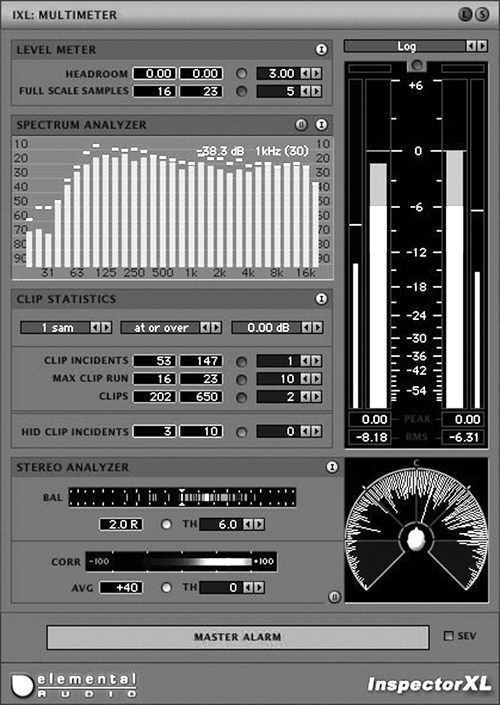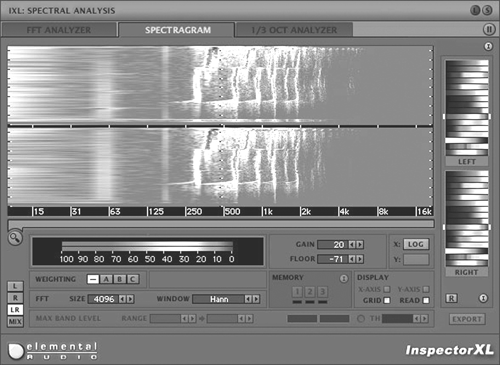
INSPECTOR XL
As I mentioned, I’ve told everyone I know (including you Dear Reader) to download EA’s free Inspector plug-in. They could charge money for it, and it would still be worthwhile... but instead they took Inspector and pumped it up with many more metering tools, and released it as InspectorXL, a comprehensive metering system for your DAW. IXL will give you a visual representation of darned near any parameter in your audio tracks, and several you hadn’t considered, all for $89. Let’s see what you get for the money...
Once you’ve installed and authorized InspectorXL, it will show up in your plug menu as a number of different VST plugs, or as a number of different AU or RTAS plugs. You see, IXL consists of six different measuring instruments, almost all of which will appear as both a mono and a stereo version in the plug-in list. To make it simpler to discuss them, we’ll group these into four modules according to their function: Level Metering, Spectrum Analysis, Stereo Analysis, and Statistics.
READING LEVELS
The Level Metering tools are among the most comprehensive available in any editor, and most come with a big advantage in that they are large and easy to see. The level meters come in both horizontal and vertical versions, and each of those is available as a mono or a stereo meter with both peak and RMS scales. Each meter has visual alarms that you can set for clipping and headroom levels, so you get an attention-getting indication when you’re clipping or about to clip — no mistake about it.
What’s more, you can completely customize the metering display and scale divisions, change the weighting of the scales, and even calibrate the meter’s warning levels to suit the way you work. You can specify what level constitutes a “caution” area in the meters, and at what level you want to see a definite warning. Once set, you can save all the custom parameters to a preset for later recall.
The Spectrum Analyzer gives you a detailed representation of the frequency spectrum of your tracks, and this tool can be selected in either mono or stereo versions. Once you’ve called up the Spectrum Analyzer, you can select one of three tabs: FFT Analyzer, 1/3 Octave Analyzer, or Spectragram. Both the FFT and 1/3 Octave displays will look familiar to you, as the FFT plots frequency as a continuous line, while the 1/3 Octave shows frequency strength on vertical bars like a real-time analyzer... well, that’s because it is a real-time analyzer. Both have similar settings and controls in the lower half of the screen for adjusting Decay and Hold times on their displays, and for setting alarms to warn against overs in a particular frequency band.

PRETTY COLORS
The Spectragram tab on the Spectrum Analyzer is a bit different than the others, in that it displays your tracks’ frequencies as bands of color. The horizontal scale is the frequency spectrum, and as audio plays the meter generates bands of color for each frequency to show loudness, with red being loudest and blue-to-black being softest. It’s harder to describe than it is to use. There’s a number of different color “scales” to choose, and I find that adjusting the color scale to a very high-contrast color set helps make it easier to understand what I’m seeing at a glance.
IXL comes with a comprehensive Stereo Analyzer that features a number of useful displays, in particular the Stereo Phase Scope. This guy shows you at a glance how wide or narrow your stereo field is, and whether a mono signal is out of phase between channels. You can view it as a graphical Polar display with little green “rays” emanating towards a “head” in the center, or as the familiar XY and Vector diagonal lines. Not only is it fun to watch, but it’ll warn you of incompatibilities long before they become real trouble. Needless to say, the Stereo Analyzer is the only plug that doesn’t have a mono version. Right?
IXL comes with a Statistics display that tracks clip incidents and overs, and lets you define when something bad is really Something Bad. Again, it’s available in a mono and a stereo version, and it comes with nice, bright bars that light up in red when your signal clips.
InspectorXL brings it all together in the Multimeter, which gives you smaller versions of the FFT, vertical Level Meter, Clip Statistics, and Stereo Analyzer all in one panel. It presents a whole lot of information in a reasonably small area. And like the other panels, the Multimeter uses sliders to control levels, and allows you to enter values by clicking in a field and typing. Most displays and alarms can be reset by just clicking on them. This makes them very easy to use, even when the display is a complex one like the Multimeter.
DOWNLOADING JOY
Like all Elemental Audio products, InspectorXL is a download-only product and comes with a PDF manual. The manual weighs in at 198 pages, and it’s a work of freakin’ art. As an education document it’s worth half the product price... if you don’t know the difference between A weighting, B weighting, and C weighting, then buy the product and read the manual. ‘Nuff said.
I use the heck out of InspectorXL. It puts very little strain on the CPU, so I put it on all my music tracks, as well as on the master fader track. In fact, IXL puts all of 4% on the CPU in Sound Forge, and that’s on a 1GHz Pentium IV. It will run on a P3 under Windows ME or better, and on OSX on a Mac.
If you have ever had a client complain about your work being too loud or too soft, or if you’ve ever had a stereo spot fall out in mono, then get InspectorXL. In fact, if you can no longer see your editor’s metering clearly due to age, overwork or substance abuse, then get InspectorXL. And with multi-channel HD radio becoming a possibility, we’re all gonna need the best and most detailed metering we can get. As far as I’m concerned, IXL is a must-have.
Visit www.elementalaudio.com and download the demo. Try it out, use it for awhile, and then don’t buy it for $89. Go on, I dare you.
♦

